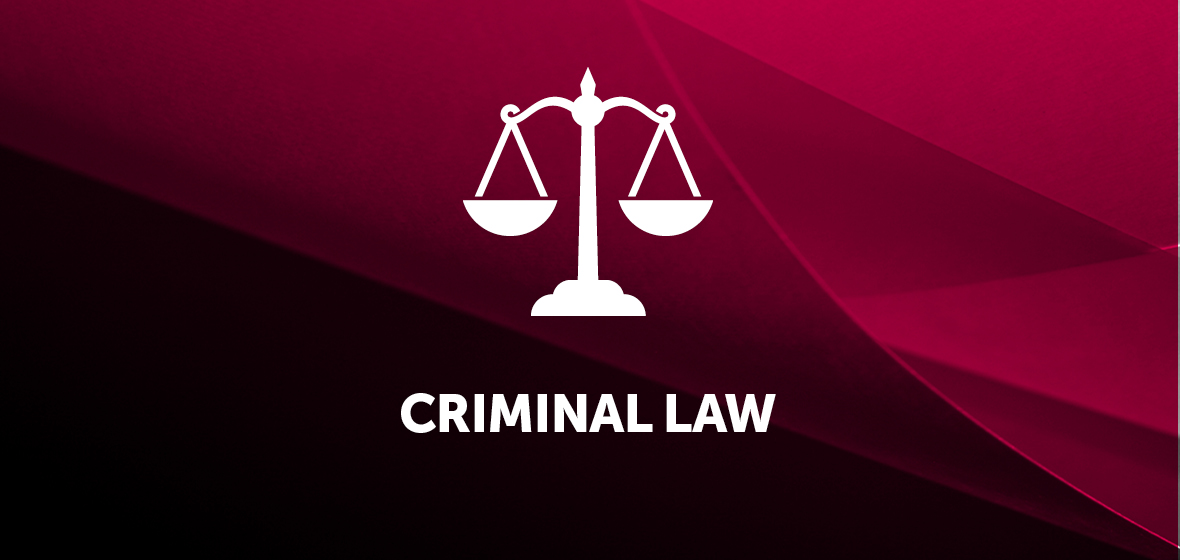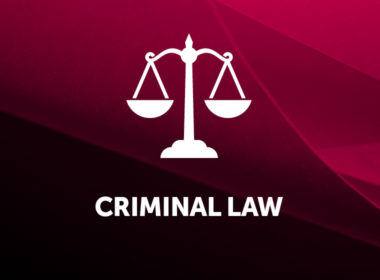Key decisions
- R v Riley [2020] NSWCCA 283
- Eakin v R [2020] NSWCCA 294
R v Riley [2020] NSWCCA 283
Illegally-obtained evidence – discretion to admit – standard of appellate review
In this decision, the Court of Criminal Appeal (‘CCA’) considered a case where illegally-obtained evidence was rejected by a trial judge. In making the determination, the CCA held that the probative value of the evidence must be taken at its highest, excluding (in all but the most extreme circumstances) the risk of contamination, concoction or collusion. In considering this kind of scenario, the Court determined that there is only one correct answer to the question of admissibility, which has consequences for the standard of appellate review.
The respondent (this was a Crown appeal) faced trial for dangerous driving causing death to one victim, and grievous bodily harm to a second, whilst under the influence of a drug; the victims were his partner and her daughter. After the accident he was taken to hospital and a blood sample was taken. What happened with the blood sample is key, but in due course a lab result was produced showing that he had cannabis and other drugs in his system and, based on that material, experts gave evidence the drugs would have impaired his ability to drive.
The Regulations required the blood sample be sealed when it was taken. The evidence established that the procedure involved two seals – an inner and an outer seal. When the sample came to the lab for testing, the inner seal was still there, but the outer seal was not. The trial judge considered this to be in breach of the Regulations, rendering the evidence illegally obtained. It was therefore necessary to determine whether the desirability of admitting the evidence outweighed the undesirability of admitting evidence that had been obtained in the way that the evidence was obtained (Evidence Act 1995, s 138). The trial judge excluded the evidence. Having been left with no case, the Crown appealed to the CCA.
The CCA (Bathurst CJ, Button and Wilson JJ agreeing, each with some brief additional remarks) allowed the Crown’s appeal.
There were two main issues: the admissibility of the evidence, and a question of the standard of appellate review.
In considering the admissibility of the evidence, the CCA found the trial judge erred by concluding that the onus lay on the Crown to disprove illegality (at [36] and [115]). It was correctly conceded on the appeal that the accused bore the onus of proving illegality or impropriety, but once that onus was satisfied the onus fell on the Crown to establish that the evidence should be admitted pursuant to s 138 of the Evidence Act.
The trial judge found (and it was not challenged on the appeal) that the outer cap had been placed on the vial, but it was removed at some time before it arrived at the Police station several days later (at [116]). That was not the same as a finding that the blood sample had been tampered with. Rather it was a finding that the Crown could not prove beyond reasonable doubt that the sample was taken in accordance with the Regulations (at [117]). The outer cap was to tamper-proof the sample, but the inner seal was there to maintain the scientific viability of the sample. There was no evidence that the inner seal had been removed or the integrity of the sample compromised – although it remained a possibility that was the case (at [119]). The trial judge was obliged, in accordance with High Court authority, to assess the evidence at its highest. Although the absence of the outer cap cast some doubts on the reliability of the evidence, that would ultimately be a matter for the jury in assessing the evidence (at [120]).
The CCA rejected a submission that in considering the probative value of the evidence of a witness such as the analyst in this case, the unreliability of the material upon which the witness based their opinion can be taken into account. The removal of the outer cap at most resulted in the possibility of contamination of the sample and the jury would be entitled to reject that possibility. Taken at its highest, the evidence of the analyst in this case would have very high probative value (at [122]). Furthermore, High Court authority also held that, unless the risk of contamination, concoction or collusion is so great that the jury could not rationally accept the evidence, then the determination of probative value excludes consideration of credibility and reliability (at [123]). In then redetermining the question under s 138, the CCA determined that the desirability of bringing to account a potential wrongdoer outweighed the desirability of curial approval or encouragement of the taking and handling of blood samples as occurred in the present case (at [131]).
In relation to the question of the standard of appellate review, the Court ultimately considered it unnecessary to decide the issue (at [114], [134], [140]). However this case does have important consequences, given the live debate about whether different standards might be applied when appealing against different decisions within the Evidence Act (and indeed different standards as between states). At issue is whether or not those appeals relating to evidentiary determinations under s 138 (and, by analogy, some other sections which require a balancing of competing factors) require the appellant to establish an error of the kind set out in House v the King (1936) 55 CLR 499. The House v The King standard can be summarised to mean a judicial officer taking into account something they should not, failing to consider something they are obliged to consider, or making some unidentified error resulting in a decision which despite no patent mistake is clearly wrong. Having reviewed the various authorities (at [89]-[110]), it was considered that the decision of whether evidence is admissible under s 138 demands a unique outcome. That is, it is capable of only one correct answer (at [111]). As a result, the Court held, in obiter, that appellate review of a decision to admit or reject evidence under s 138 is not subject to the judicial restraint of the kind mentioned in House v The King.
In practice, that probably places a higher burden on trial judges, since it will not be enough to make a decision which is open to them, the trial judge must in fact make the correct decision.
Eakin v R [2020] NSWCCA 294
Parity principle – where co-offender’s sentence reduced on appeal – where appellant already had a lower sentence
In this decision, the CCA allowed an appeal to reinstate the original parity between co-offenders. It was found that in circumstances where a sentencing judge sets up a parity relationship between offenders, and a co-offender subsequently gets their sentence reduced, it might give rise to a justifiable sense of grievance – even if the first co-offender already had a lower sentence.
The applicant was a Customs Officer. He was paid $100,000 by the co-offender (herself a former Customs Officer) to shepherd a consignment of cigarettes through customs, evading the payment of more than $6 million in duty. Each was charged with aiding and abetting the importation of tobacco products with the intention of defrauding the revenue; and respectively either bribing a public official or receiving a bribe as a public official. The co-offender also had an additional charge of dealing with proceeds of crime. When they were first sentenced in the District Court, the applicant’s sentence had been about 73 per cent of that of his co-offender, but the co-offender successfully appealed her sentence (the grounds are not relevant at present). After her sentence was reduced, the applicant’s sentence went up to 89 per cent of his co-offender’s. In other words, the difference between the two sentences was reduced because of the co-offender’s successful appeal.
The applicant appealed. He sought a reduction of his original sentence (4 years, with a non-parole period of 2 years) to correct the disparity which the co-offender’s successful appeal had created. In effect the applicant wanted his sentence reduced by about the same percentage that the co-offender’s sentence had been reduced, in order to re-establish the original ratio between their sentences.
By majority (Price J, Rothman J agreeing with additional reasons; Basten JA dissenting) the CCA allowed the appeal. In the kind of outcome that causes headaches for authors of case summaries, each judge provided different reasons for their position.
Price J considered that the ‘kernel’ of the applicant’s justifiable sense of grievance could be seen by reference to their undiscounted starting points after the co-offender had been resentenced. Even though he had lower overall criminality, after the co-offender’s appeal the applicant had a higher undiscounted head sentence, and a non-parole period which was only two months shorter (at [132]-[134]). In Price J’s view, the parity principle does not apply only to the offender who receives the more serious sentence (at [123]). How then, his Honour asked rhetorically, can the notion of equal justice be fulfilled by a higher undiscounted aggregate sentence being imposed on the offender with the lesser total criminality (at [136])? In his Honour’s view, it could not – with the consequence that there had been an error (at [137]).
In joining Price J as to the outcome, Rothman J set out his reasons somewhat differently. His Honour considered that where a judicial officer has established a parity (by which, presumably, his Honour means a ratio between offenders) that is not plainly wrong, it should not be disturbed except for a good reason (at [51]). In this case, the sentencing judge arrived, intuitively, at an appropriate relationship between the sentences between the offenders which was correct, notwithstanding the issues which gave rise to the successful appeal against the co-offender’s sentence (at [69]), and that should be maintained.
Basten JA was in dissent. His Honour considered that the CCA’s decision in the co-offender’s matter may have been wrongly decided (at [36]). However, on the assumption that it was correct, there were said to be five reasons why the successful appeal in the co-offender’s case should not affect this offender, the most obvious of which was that the CCA must have already considered parity when it came to resentence the co-offender (at [29]-[33]).
As a practical consideration, this decision has the potential to be very important in matters where there are co-offenders. It means that if practitioners are representing an offender who is early in the queue of offenders to be sentenced, they will need to monitor the outcomes in the subsequent matters to see whether their outcomes might not give rise to appeal after all – even once they have eventually been sentenced and potentially appeal.



